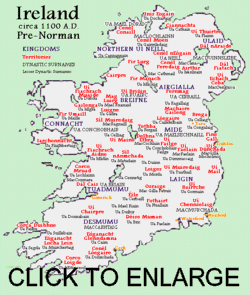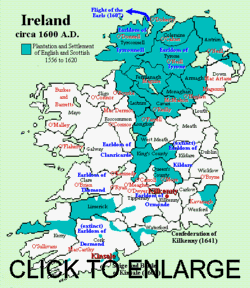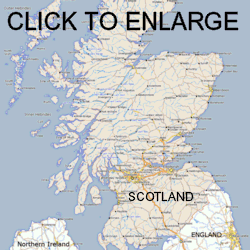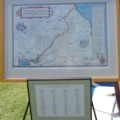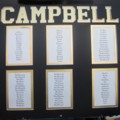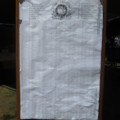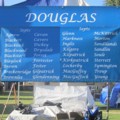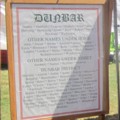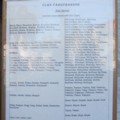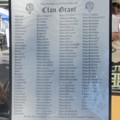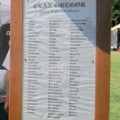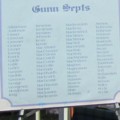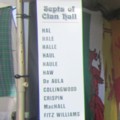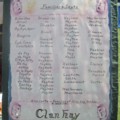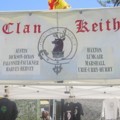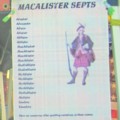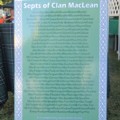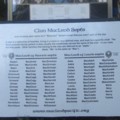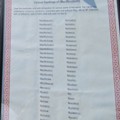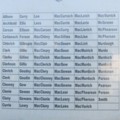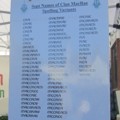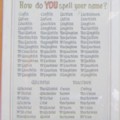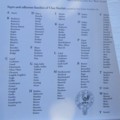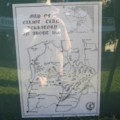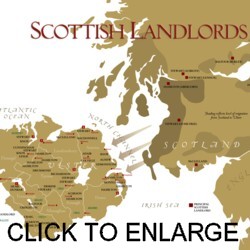Celts
|
AmeriCeltic provides accurate information on Celtic Culture and History. |
Support our work! |
Click Here to subscribe to our weekly Email Newsletter, and get updates every Friday. |
Table of Contents
Who are the Celts
Who are the Irish Americans
Who are the Scots
Who are the Scottish and Scots-Irish Americans
Chronicles of the Scots-Irish
Who are the Welsh Americans
Galicia and Asturias
Who are the European Celts
Revitalizing Gaelic in North America
Who are the Celts?
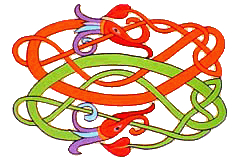
A Typical Celtic Motif
‘Celt’ generally refers to people from Ireland, Wales, Cornwall, Scotland, the Isle of Mann, Brittany (in France), as well as Galicia and Asturias in Spain. But most of the peoples of Europe, with the exception of Italy, southern Spain and Greece, are Celtic in varying amounts.
Celts originated in Central Europe at the beginning of the Iron Age, about 1200–1000 BCE. The concensus is that the word ‘Celt’ is derived from the Greek ‘Keltoi’, which the ancient Greeks used to refer to their neighbors to the north. These ancient Celts established a lasting legacy of Celtic culture behind in these originial lands, which includeed parts of Switzerland, Austria and Hungary. Celts soon dominated all of Northern Europe, parts of northwest Asia, the Balkans, and Spain, and Romans called them Gauls (in Latin, Galli). By about 500 BCE, Celts had moved into the islands of Britannia and Ireland, and they called themselves Gaels, but by the 17th century, scholars began referring to all of these groups by the term ‘Celt’. Scandinavians, Germans and Slavs generally have evolved from these older Celtic peoples, but over succeeding millenia also assimilated other peoples from further East.
These ancient Celtic peoples were extremely aggressive and warlike, but then as now, loved words, music, art and a having good time. Ancient Celtic art was full of interlacing patterns, spirals, animal forms, and color. The early Celts displayed their art especially in metal: jewelry, weapons, figurines and pots have been found. Many Celtic festivals are held around the country each year. Most early immigrants to America from Europe have significant Celtic ancestry. America surely is richer for the presence of the Celts here.
Who are the Irish Americans?
Two-thirds of Celtic Americans arrived here from Ireland, but only half are descendants of families that lived in Ireland before the Norse and Norman-English (Norse-French by way of England) invasions, and the creation of the Scots-Irish plantations in Ulster. (See Scots-Irish below.) The Anglo-Irish Irish immigrants were the first large group to arrive during and just after the Irish rebellion of 1639-41. The Anglo-Irish themselves were two groups: those who settled in Ireland in the 12th and 13th centuries when all the British Isles were still Catholic, and those who arrived after the Protestant reformation in England, Wales and Scotland in the 16th and 17th centuries. It was primarily the second group that was the first to emigrate to America, because it was Protestant during a major Catholic Irish rebellion in which tens of thousands of Protestants who stayed in Ireland were massacred.
The first group of Anglo-Irish included such names as Burke, Fitzgerald, Fitzpatrick and developed when the four traditional Irish kings were fighting for high-kingship and a unified Ireland (under who was the main dispute). Within the Irish kingdoms themselves, warfare for the kingship from among the different clans and tribes in the kingdom had also taken place. There was no tradition of peaceful inheritance of leadership of kingdoms, clans, and septs of clans, and the leader of each level favored his immediate relatives to no more than about two degrees of relationships with the choicest lands, and most opportunities for wealth and power. Being an Irish king had indeed become survival of the fittest, usually a life-long fight for said survival, and the kingdoms were themselves too weak to fight well and long among themselves because of the loss of life of so many men over the centuries.
Thus by the time the Norman kings were establishing themselves in England, and had excess warriors, Ireland’s would be kings and established kings needed men and began sending to England for excess Norman-English warriors, whom, by that time, the Norman kings were only too happy to see leave. The invited Anglo-Norman mercenaries stayed in Ireland, intermarrying with the leading families of the Irish kingdoms and being awarded large tracts of land by the kings for their services. At this time, though, everyone was nominally, if not practicing, Catholic. Within a couple of generations, the Norman lords had additionally adopted the older Irish culture and even were speaking Gaelic. By the mid-16th century they were as Irish as the older Irish families themselves, thoroughly intermarried with them, and there were few distinctions among them. When the newly Protestant Henry VIII decided to conquer and Protestantize Ireland, one of the worst set of repeated rebellions against him and his daughter Elizabeth came from the Anglo-Irish Earls of Desmond, the Fitzgeralds.
The second group of Anglo-Irish was the result of the Tudor Protestant efforts to take over Ireland and change its religion and government, especially since some of the Irish lords were only too willing to cooperate with the Spanish attempts to end the Protestant Tudor reign in England, at the behest of the Pope. By the middle of the reign of Elizabeth I, the English had some success in conquering most of the East coast and south of Ireland. It hadn’t helped the Irish ideal of independence when Elizabeth’s government literally caught several of its earls in direct communications with the Spanish to help overthrow her, in England, through developing forces alongside the Irish in Ireland. This eventually led to war between England and Spain, which Spain lost after building that huge armada of ships filled with tens of thousands of would-be invaders. Needless to say, Elizabeth I was not amused, and the lives and lands of the known and suspected Irish lords in this fiasco were forfeit. This also led to the start of the first ‘plantations‘ created by the English to resettle Ireland with loyalists. By the death of Elizabeth I, most Catholic Irish who wished to remain Catholic had left, with strong encouragement, the counties of Meath, Westmeath, Cork, Cavan, and others to settle in the western third of Ireland near the O’Malley’s, O’Flaherty’s and Burkes.
Some Irish converted to the Church of England and remained in eastern Ireland. Even some Catholic Irish were permitted to remain–with restrictions. However, a large number of newer English and Welsh families became a slight majority in what became known as ‘the English Pale,’ a large stretch of east coast Ireland and southeast Ireland, including Dublin. These families included Parsons, Loftus, Vaughns and Perrots, the last being descended from and connected to the son of an illegitimate daughter of Henry VIII and thus cousin to Elizabeth I. After the Irish rebellion of 1639-41, in which again, a few of the leaders unwisely invited Spain to participate, Ireland continued to be restive as Civil War developed between Catholics and Protestants in England itself. This climaxed in the successful Cromwellian rebellion in England, the beheading of Charles I, and Cromwell‘s subsequent ‘punishment’ of the Irish for having so much supported Charles I and the Catholics. Cromwell killed so many people, including Scots-Irish and Anglo-Irish, even members of families that had arrived during the Tudor reigns, that an inquisition and census conducted in Ireland on orders of Charles II and his first parliament, called the Petty or Pender census and survey, found that many counties in the entire eastern half of Ireland had been depopulated from previous censes done in the late 1620’s and 1630’s by as much as 80% or more. In the words of one investigator, ‘it was possible to travel for many miles in a day without seeing so much as one man or one domestic animal.’ Some of the inhabitants of the 1630-40’s had fled to western Ireland. Some had returned to Scotland and England. Some fled to Europe. Some had emigrated to the North American colonies in the first notable wave of emigrants from Ireland. However, between 50 and 60 percent of the missing people were simply killed in the 1641 rebellion, and its Scottish and English revenges, the Civil War and then Cromwell’s invasion and marches. They were not to be found on ANY subsequent records in a kingdom that was among the most sophisticated in the world for record-keeping and taxation.
After 1659, some of the Scottish and Anglo-Irish families returned from western Ireland or Scotland, and some Irish families that had been exiled to Spain and France, to the eastern half of Ireland. However, Cromwell himself had assigned lands to some newer Scots and English settlers who had served in his armies, and Parliament under Charles II permitted them to stay. Charles II then encouraged more English, Welsh and Scots to settle the remaining depopulated areas, the Scots going mostly to Ulster, the English and Welsh, southward. This resulted in a number of Catholic Irish families, not entirely trusting of Parliament and the Stewarts any more to leave Ireland and settle in Maryland, New York City and South Carolina. Again, however by the late 1700’s and the 1798 Irish rebellion, most of these most recent Anglo-Irish and Scots-Irish families, despite differences in religion, considered themselves Irish. Inspired by the American and French Revolutions, they, along with the older Irish families of all types, participated in the 1798 rebellion against England. England put down the rebellion harshly and further retaliated by ending the existence of the independent domestic Irish parliament. This resulted in the next large wave of Irish and Anglo-Irish emigration to North America, primarily to the new United States which had enacted a Constitutional amendment guaranteeing religious freedom in all of its states. This very large Irish emigration arrived at primarily the ports of New York City, Boston, Philadelphia (New Castle) and Baltimore, and spread westward and southwest from the ports. Between 1800 and 1840, before the Great Famine, just about one-million Irish of all types, including Scots-Irish, left Ireland, primarily for North America, with some going to Europe, Australia and New Zealand. Interestingly, economically, many of the Irish emigrants of this time period fell into one of two categories: weaving and glassmaking and the great glassmaking and textile industries of the U.S. began rapidly developing at this time.
Many more Irish people, began to emigrate to the U.S. during the great potato famine beginning in 1845. By 1854 nearly one and a half million Irish people, about a quarter of the population, had emigrated to the United States. So many, that the famine-Irish emigrants are far and away the largest contingent of Celts in this country. So many came that some mistakenly believe that Celtic means the same as Irish (Much to the irritation of the rest of the Celts). Every year on March 17, the Irish pull out the stops to celebrate St. Patricks Day, and the United States becomes another Celtic country.
Click this link to read more about the history of the Irish people. www.rootsweb.ancestry.com/~irlkik/ihm
Some of the more commonly found old-Irish surnames are below. These are names that are not known to be of Norse, Danish, Scottish, English, Welsh or French origination. For a more complete list of all Irish names, click on the link for Irish history in maps, which has its own link to a names site. I’ve compiled this list from several sources, not all of which are on-line, yet. The prefixes of ‘Mac, Mc and O’ were often used interchangeably and at times dropped entirely and then sometimes restored. Thus this list is alphabetized according to the main bodies of the surnames.
O’Aherne, McArdle, MacAuliffe, O’Bannion, O’Beirne/Byrne, O’Brannigan, O’Brady, Mc Breheny, O’Brennan, O’Breslin, O’Brien, O’Brady, O’Brody, Brosnan, McCaffrey, McCafferty, O’Callaghan, McCann, O’Carey, O’Carroll, Mc Carthy, Cassidy, McCluskey/McCloskey, McColl, Collins/O’Cullen, McConnell,Connolly, McConnor/Connor, Conroy–in fact most names beginning with ‘Con’ once indicating they came from Connaught, Corcoran, O’Corrigan, McCotter
O’Dempsey, Donaghue, O’Donell/O’Donelly, O’Donovan, O’Doohan, Dooley, Doolittle, O’Dorne, O’Dougherty, O’Dowling, O’Dunne, O’Dwyer, McEagan/Eagan, McEvoy, O’Fahey, O’Fallon, O’Farrell, Feeney, Fitzpatrick–originally McGilpatrick/McKilpatrick: the Normans changed the name to ‘Fitz’patrick; O’Flaherty, O’Flynn, O’Fogarty, O’Gara, McGarvey, McGill, O’Glaisin/Gleason, Magee/McGee, McGinnis/Guinness, McGoohan, O’Grady, McGuirk/McGurk
O’Hagan, O’Hanlan, O’Halloran, O’Hara, Hannegan, O’Haggerty, O’Herlihy, O’Hogan, O’Hallahan, O’Houlihan, McInerney/McNerny, O’Leary, O’Kane/Keane, O’Kearney/Carney, O’Keefe, Keagan/MacKeegan, O’Keenan, O’Kennedy, O’Kieran, McKiernan, Kilpatrick, O’Kirwan/Kerwin, Kilroy, Kerrigan, Lanigan, O’Leary, O’Loughlin
O’Madden, O’Malley, Malone/Malony, McMahon, MacManus, O’Meara, O’Molloy/Mulloy, O’Mooney, Moylan, Moynihan, O’Moran, O’Morrissey, O’Moriarty/O’Murtagh, O’Mulcahy, O’Muldoon, O’Mullaney, Mullarkey/Malarkey, O’Mullens, O’Mulligan, McNamara, McNary/O’Neary, O’Neill/Neal, O’Nolan, McNulty, McQuaide, Quilty, O’Quill, O’Quinn/Coyne, O’Rafferty, MacRannall/Randall, O’Regan/Reagan, O’Reidy/Ride, O’Reilly, O’Reddy, O’Riordan, O’Rourke, MulRooney/Rooney
Scallan, O’Scanlon, McShane, O’Shannon/Sheenan, O’Shaughnessy, O’Shea, O’Sheehan, O’Sheridan, Slattery, Spillane, O’Sullivan, Talty, McTansey, O’Tierney, McTighe/McTeague, O’Toole, O’Tracy, Tuohy/Twohey, O’Tuomey/Toomey, Tunney, McVeagh, Whalan/Whelan
The Scots and Scots-Irish are the second largest group of Celts in the U.S., having contributed about a million and a half emigrants, with the Welsh, Cornish, Bretons and Galicians in smaller numbers. How many Celtic-Americans are there here? Because most Americans are now only part-Celtic, it’s hard to say. However, by using the same rule of thumb of ‘dominant’ ethnicity being a quarter or more that is traditionally used for African Americans or Native Americans, and examining census records and such, population experts estimate the Celtic American population at between 40-50% of the U.S. population.
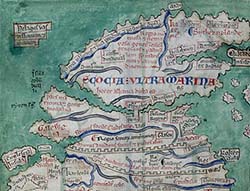
Matthew Paris Map of Scotland
Who are the Scots?
First, it’s helpful to understand that Scotland was not a unified nation in ancient times. In Roman times, the Romans called the land Caledonia and the southern border was the Roman built Hadrian’s Wall. The Romans called these people ‘Picti‘. The Roman name ‘Scoti‘ was used to refer to the peoples bordering the Irish sea including the kingdom of Dal Riata in the Northeast of Ireland and western Scotland, including many islands between them. After the Romans left, the king of Dal Riata, including people from the Argylla territory just south of the main part of the kingdom, began taking over more of the western and central regions of Caledonia, and moving into the old ‘Strathclyde’ areas, and calling the land Scotland. This was between the 4th and 7th centuries. By the middle of the 9th century, the heirs of Dalriada had intermarried with the royal family of the Picts, and the unified kingdom became known first as Alba then as Scotland. The Dalriadic kingdom had also become Christian. The original Pictish language was lost as the Picts were submerged beneath both Dalriada and Christianity. It is believed by many scholars that the ancient Pictish language was related to Welsh. The rest of Strathclyde, which included parts of northern England also was absorbed into the new Scotland. So, originally, Scotland included what is now Cumbria, Durham and Northumberland in modern England. The original Scottish southern border ran along Hadrian’s Wall between Newcastle-upon-Tyne in the east to Carlisle in the west, and sometimes south of the old wall. Irish people from what is now Ulster continued to go back and forth between Ulster, Argyllshire and Ayrshire in Scotland up until the Norman conquest of England. Norse-Irish who developed as an entity slightly before the Norse-French (Normans) then conquered lands in what is now England as far south as York, and intermarried with the Scots royal family. Most of Scotland, what is now northern England, and northeast Ireland shared one culture for over 700 years.
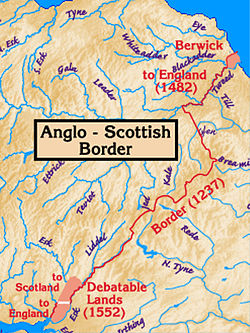
Anglo-Scottish Border
The Norman kings of England first tried to conquer Scotland with no real success. It was the Angevin kings of England that began to make inroads, starting with Henry II, who at first recognized Scottish suzerainty over Northumberland and Cumbria, then changed his mind and unilaterally claimed it when the old Scottish king died and an adolescent took the throne. Henry II then changed his mind yet again and unilaterally recognized a kind of ‘joint’ ownership of the area with the King of Scotland administering and protecting the area but paying a feof to the King of England to have that right (an early form of extortion, or ‘shotgun marriage’ it would seem). This arrangement was forced upon the Scots and was named by the English, the Treaty of 1237. Since it was not freely negotiated by two parties who equally wanted such an agreement, and unilaterally forced upon the Scots, most Scots considered it invalid and ignored it. Thus, about 60 years later, Edward I tried to conquer these areas and then the rest of Scotland. Initially beaten decisively by Scottish hero William Wallace his son, Edward II, effectively ceded the old Scots lands back to Scotland. However, after Edward II, his son Edward III was seizing lands again. So it went, back and forth, until the battle of Flodden Field, in 1513 which finally put the English in perpetual control of Cumbria, Durham and Northumberland to the present day. However, during these centuries before Flodden Field many well-to-do families established family properties in both the southern counties of what remained Scotland and in Cumbria, Durham and Northumberland.
These families included Bruce, Woods, Elliot, Armstrong, and other generally-regarded-as Scots families. The families themselves usually call themselves Scots. Indeed, there is one current association of Clans and Families that call themselves the ‘Scots Border Riever Families‘, and never sing ‘God save the Queen’.
Second, Scots families came to include Irish, Norse, Norman (Norse-French), Breton and other French named families from the centuries of warfare over the border, coasts and islands, and the emigration of mercenary knights from France for various reasons. Later, in the 14th and 15th centuries, Flemish families also settled in parts of Scotland at the invitation of Scottish kings and nobles who wanted to improve weaving and breeding better wool sheep and flax for cloth. Thus, Scottish names are not always what one might think they should be, and millions of Americans have Scottish ancestry and don’t realize it.
Who are the Scottish and Scots-Irish Americans?
Scots began to come to America as early as 1607, under the first of the Scottish Stewart kings of England. By the early 1700’s, dozens of names, recognized by the Scots as Scottish names, are found among Scots colonists in the Americas. Between 1713 and 1839–the end of the Scottish famine, over 1.5 million Scots emigrated to North America, most to what became the U.S. Many thousands of descendants of Scots who emigrated to Canada also moved to the U.S. in the mid to late 1800’s.
The following pictures of lists of common names from about 2 dozen of the more than 100 Scottish clans. This is are not a full list of Scottish names, but these names had become affiliated with these often larger Scottish clans. There were also district names, often taken from towns and landmarks, some of whom intermarried with clan affiliates, but not all did. These pictures of clan list names were taken in 2011 in Pleasanton, California at the largest Scottish festival in the western U.S.. These pictures are here to help the curious determine if they might have some Scottish ancestry and if so, the family’s likely early relationships and where they might have come from in Scotland. We’ll try to add more lists and pictures as time goes on.
Many Americans of Celtic descent also mistakenly believe they are Irish when in fact they are Scots-Irish. Scots-Irish Americans are descendants of Scots who lived in Northern Ireland for two or three generations but retained their Scottish character and Protestant religion. Scots went to Northern Ireland beginning when the Scottish Stewarts took over the throne of England, just after 1601. The late Elizabeth I of England had just defeated and driven out the duplicitous Earls of Ulster and between that war and the warfare between the earls themselves just before they joined to renege upon their English treaties, the land had become largely unpopulated. Elizabeth I’s son, James I, decided that to prevent other troublesome Irish from moving into the area, he would create new colonies for Protestant Scots and English.
Not many English wanted the poorer lands of Ulster, but the more industrious Scots did because improvements in Scottish agriculture, livestock, and crafts and commerce had led to a population explosion in Scotland after 1513, and the people were literally running out of useable land. Thus Ulster by 1640 was inhabited by a Scottish majority–and by 1700 had literally hundreds of thousands of Scots families living there. However, their descendants are mostly unaware of how northern Ireland came to be settled and dominated by Scots between 1600 and 1700. They know only perhaps that grandpa’s or grandma’s family Bible shows they came to America from Ireland, or that there’s an importation record in an eastern seaboard state that says they arrived from Ireland in such year, and they believe they are simply Irish.
The earliest large group of Scots-Irish mixed with Scots emigrated because they were Presbyterians being persecuted by James I son, Charles I. King Charles ordered them to accept bishops he appointed, which they did not want nor would they swear the loyalty oaths to the Church of England/Scotland he demanded in exchange for recognition of their Presbyterian ministers.
The Puritans, English Congregationalists who dominated Massachusetts, then invited the Scots-Irish and Scots Presbyterian ‘dissenters’ to settle among them. Scots-Irish and Scots dissenters then were arriving by the multiple ship-loads in Massachusetts by the 1640’s. However, the Massachusetts Congregationalists soon began complaining about the less modest dress of Scottish/Scots-Irish women and the freer, less disciplined Scottish children. They also did not agree with the Scots insistence on educating all their children, girls as well as boys, to read write and do arithmetic, and to allow women to be elders of the Presbyterian church congregations. Soon Massachusetts was settling Scots-Irish and Scots emigrants on its most dangerous frontiers and requiring double tithes of the Scottish Presbyterian communities where there were both Presbyterian and Congregationalist churches. By the late 1600’s Scots-Irish and Scots were being clearly treated as less desirable second class citizens in Massachusetts and they were no longer emigrating in large numbers to Massachusetts.
Many later Scots-Irish and Scots who already had relatives in Massachusetts were emigrating to New York, and settling along the New York frontier with the Iroquois, or in safer New Jersey. Also, eventually the split between the Scots and Scots-Irish Presbyterians and the English Congregationalists in Massachusetts led to the development of the separate colonies/states of more Scottish New Hampshire and Vermont.
The next large group of Scots-Irish combined with Scots first arrived in Virginia also as a result of persecution by Charles I in the 1640’s. However, many more Scots-Irish and Scots then arrived between 1649 and 1660, because they and the Commonwealth of Virginia were loyalists to the Stewarts, and against Cromwell. They settled in Virginia and Maryland, which, as a Catholic colony, and so loyal to the Stewarts, welcomed them. The next group settled in Maryland in the 1670’s-80’s, on the eastern peninsula, including what became Delaware, which was not its own separate colony until the 1770’s.
Then came the largest of all of the early Scots-Irish and Scots waves of emigration between 1713-1746. This was when the Scottish Stewarts were replaced by the German Hanovers as the ruling family of England and Scotland. The Scots no longer enjoyed as much attention, favor and commercial privileges under the Hanovers. Worse, after the Act of Union became fully implemented, Ulster found itself left out and had none of the commercial privileges enjoyed by Scotland itself. Ulster was not permitted international trade, only trade with England and Scotland, causing a collapse in the economy. At the same time the landlords were allowed, in violation of previous Stewart mandates and restrictions, to drastically raise rents on lands that were supposed to have been sold to plantation tenants but never were. The resulting group of hundreds of thousands of Scots-Irish and Scots emigrants, primarily arrived through what had become the Pennsylvania port of Newcastle, the main port of Philadelphia itself. The group mostly settled initially in the Maryland counties closest to existing Pennsylvania counties, and in Chester and Lancaster counties in Pennsylvania and the counties that became Delaware.
However, Pennsylvania was slow to sell or grant lands to the new emigrants and Virginia decided to welcome them instead in the 1730’s. The result was that more than half of the Scots-Irish and Scottish families who first tried to settle in Pennsylvania went south from the Potomac through the Shenandoah Valley into Virginia and settled the Piedmont, Great Valley, adjacent valleys, and the eastern parts of the Blue Ridge in Virginia, Maryland and North Carolina. Some of the post 1713 Scots-Irish and Scots who had arrived at Newcastle, also went to Baltimore, along with Maryland descendants of earlier generations of Scots-Irish and Scots. These groups together built up Baltimore as a major commercial port city, like Glasgow back in Scotland, which became a major trading partner.
By the time of the American Revolution, one more significant group had arrived in North and South Carolina after the defeat of the Scots and Scots-Irish trying to restore the Stewarts at Culloden and the subsequent massacres of Scots by the Hanoverian Duke of Cumberland. Just before the American Revolution, in 1771-3, a rebellion of mostly Scots-Irish in North Carolina, against English landlords, called ‘The Regulators Rebellion‘, resulted in severe punishment by Governor Tryon and many Scots-Irish and Scottish families then fleeing to South Carolina, where they settled in the old Spartanburg and Ninety-six Districts.
Click this link to read more about the Scots-Irish Americans.
Chronicles of the Scots-Irish
Chalkley’s Chronicles is three volumes of summary transcriptions of all the county records for Augusta County, Virginia, with parts of Orange, Albemarle, Rockbridge, Rockingham and Amherst counties as well–whose settlements in the 1700’s were heavily Scottish and Scots-Irish. These volumes, together, give an excellent presentation of the lives and communities of hundreds of Scottish and Scots-Irish families soon after they emigrated (about 1710-1746 for most, as early as 1650 to 1690 for one earlier group), to about 1790,as they were in Pennsylvania, Maryland, Virginia, North and South Carolina. Most were Presbyterians, but some were Church of Scotland (Episcopal, Scottish version of Anglican).
Click this link to read about Chalkley’s Chronicles of the Scotch-Irish Americans.
Every 2 and 4 years, politicians like Jim Webb spout off about traditional American interests, values and lifestyles. Since the Scots and Scots-Irish comprised either fully or partly the ancestry of about half the signers of the Declaration of Independence and the Constitution, and nearly three-quarters of Washington’s army and more than one-half of his officers corps, were Scots, Irish, and Scots-Irish. More than any other group. These are the real foundation of America. Chalkley’s Chronicles, thus, is a detailed look at the first 100 years of the people who laid the foundation of the modern U.S. As we have seen, our politicians should read these to REALLY understand the Scots-Irish people in them and to fail to do so puts our entire society at extreme risk!
↑Top↑
Who are the Welsh Americans?
The word ‘Welsh’, was first used by the pagan Angle and Saxon invaders, who first came to the island of Britannia in the 6th century AD, and spoke a Germanic tongue. For these Anglo-Saxons, these Christian speakers of Gaelic and Latin were called ‘Walhaz’, meaning “foreign” as they were driven to the extreme West of the island, their remaining lands came to be called ‘Wales’.
Although some Catholicism remained in Wales after the Welsh King, Henry Tudor became Henry VII King of England, and when his son, Henry VIII broke with Rome, most had converted to the Tudors’ new ‘Church of England‘, and so were considered loyal to the crown. Thus the Welshwere among the earliest settlers brought to Ireland by the Tudor dynasty’s first attempts to reform the religion and government of Ireland. As Protestants in Ireland who were also closest to the English, they became the first and main targets in the Irish Catholic rebellion of 1641, and many emigrated to North America to avoid massacre. Some went to Massachusetts, but most went to Virginia.
A significant number of Welsh became Quakers in the 1600’s, and rejected war, and were persecuted for refusing to serve in the Kings armies; some were even hung! Many went with English Quakers, more arrived in what became Pennsylvania (then part of Maryland) and Virginia. The next large wave of Welsh settlement occurred with the emigration of Quakers to the newly established Quaker colony of Pennsylvania in the 1680’s. In the early 1700’s, Welsh who were concerned about the Church of England being too secular, created a more fundamentalist sect which is now the Methodist church. Up until about 1730, they were in such numbers in Pennsylvania, that several governors of Pennsylvania were Welsh. During the 1730’s, the earliest days of the industrial revolution, they were in high demand, along with the Cornish, for mining in the early expansion of the United States westward. The last significant wave occurred in the 1790’s to the 1860’s–virtually every time a new mining area for any lucrative metal from iron and lead to gold and silver was discovered. However, because Wales was the smallest of the Celtic nations in population, the emigration from Wales is a distant third in numbers to that of Ireland and Scotland, estimated to be no more than about half a million, total, from 1641 to 1870. There is also some confusion about the distinction of surnames since several such as Lewis and Thomas are found in both Scotland and Wales and it’s hard to determine origins since these surnames were typically both in Scottish and Welsh areas that traded with one another for many centuries. Additionally, the old Celtic kingdom of Strathclyde which included parts of Southern Scotland was closer in culture and language to Wales. When Strathclyde disappeared, its people remained in the areas they had settled again sharing surnames but now in different kingdoms. Wallace, originally Ness, is an example of a Welsh-Strathclyde family that ended up in Scotland. More recognizable Welsh surnames include Bronwyn, Cadogan, Cardiff, Cardigan, Cadwallader, Davies/Davis, Evans, Floyd, Griffith, Griffin, Llewellyn, Lloyd, Merrick, Meriwether, Morgan, Ness (which can also be Scottish), Owen, Powell, Rhys/Rice, Taafe, Trevellyan, Tudor/Tyder, Vaughan and Wetherell.
After the last glaciation period in Europe began to ease about 10,000 years ago (~8000 BCE), the people who had retreated south of the glaciers in the Iberian peninsula began to gradually migrate north, and some made it as far north as the islands of Britania and Ireland, which lie due north from the Northwestern coast thereof.
At about the same time, the Celtic culture began to develop east of the Alps mountains, in what is now Austria, and this Celtic Culture eventually spread westward, where the two groups met and mingled.
By about 500 years BCE, the Celtic Culture had begun to leave evidence that they to had arrived in Britania and Ireland, and oral traditions have long claimed that they had arrived by sailing north from North West Iberia, the area we now call Galicia and Asturias, bringing their Celtic traditions with them.
Here is a link to an recent article by Amelia Hogan, Returning, Riotously Joy-Filled, about this ancient connection between Ireland, and the Celtic Cultures, especially musical tradtions, of Galicia and Asturias.
Who are the European Celts?
Many Europeans are of Celtic descent, but because their ancestors adopted political and cultural influences from the Greeks, Romans, Muslim or Asiatic invaders, they do not think of themselves as ‘Celtic’. Recent studies show their genetic heritage is Celtic. One study shows that Germans, Scandinavians, and Irish share over 80% of the important genetic markers.
Sin sibh!
(Greetings! – literally y’all!)
Is mise an t-Ollamh Àdhamh Dàmaireach, agus tha mise is a’ bhean agam, Dàine Nic a’ Bhàird, a’ feuchainn ri Gàidhlig na h-Alba ath-bheòthachadh ann an Aimeireaga a Tuath.
(I’m Dr. Adam Dahmer, and my wife, Dhanya Baird, and I are trying to revitalize Scottish Gaelic in North America.)
You might now be wondering what Scottish Gaelic is, why we would want North Americans to speak it, and how we plan to go about equipping them to do so. If that be the case, you’ll be pleased to hear that, in the following paragraphs, I intend to explain exactly that!
What’s Scottish Gaelic?
Scottish Gaelic, or Gàidhlig, is one of the six living Celtic languages, along with Irish, Manx, Welsh, Cornish, and Breton. Of these languages, it is a ‘Goidelic’ or ‘Gaelic’ language, meaning that it is more closely related to Irish and Manx (the other Goidelic languages) than it is to Welsh, Cornish or Breton (the Brittonic or Brythonic languages). Many Irish and Manx speakers can even understandably converse with Scottish Gaelic speakers in their own languages without having studied Scottish Gaelic!
Why teach it to North Americans?
A good question, to which there are many compelling answers.
For one thing, Gaelic is a highly endangered language. Even in its home country of Scotland, less than two percent of the population knows how to fluently speak it, even though it used to be widely spoken throughout the country. This is especially sad in light of the fact that most Gaelic speakers didn’t give up the language of their own accord: many surrendered it only reluctantly, in the face of centuries of persecution and marginalization by the governments of Scotland and the United Kingdom. From the de facto expulsion of Gaelic culture from the Scottish Lowlands in the High Middle Ages, to the destruction of the Lordship of the Isles in the fifteenth century, to the passage of the Statutes of Iona in the seventeenth century, to the brutal defeat of the Jacobite risings in the eighteenth century, to the Highland Clearances of the nineteenth century, Scottish Gaelic and its speakers have been subject to injustice after injustice at the hands of nation-states that should been safeguarding their best interests, or at the very least leaving them in peace to oversee their own affairs. By the twentieth century, the powerful were at last content to leave Scottish Gaelic alone – but only when the culmination of their past interventions had already practically dealt it a deathblow.
Now, ironically, after centuries of contraction and diminution as the result of outsider meddling, the Scottish Gaelic community requires outside aid in order to survive – and it is our duty to provide it.
Just as we have an obligation to protect threatened animal species that face human-caused ecological extinction, we are obliged to protect threatened languages that face human-caused linguistic extinction. Gaelic is one of the languages that needs our help to survive, and teaching it to people – whether they live in Scotland or elsewhere – is one way to ensure that the language thrives.
For another thing, learning Gaelic in North America is a way of showing solidarity with the members of North American communities, who – like the Scottish Gaels in Scotland – have historically felt majority pressure to abandon their mother-tongues. While the speaker of an Indigenous North American language like Chickasaw or Yuchi – or of a minoritized range of dialects like Black American Vernacular English – might or might not want someone outside their community to learn their speech variety, they will often take courage from the presence of another non-Standard-English language or dialect. In a culture where Standard English threatens all other forms of speech, any deviation from Standard English is a heroic act of defiance, and proof that endangered speech varieties of any kind still have a voice.
Finally, there are a lot of people in North America whose ancestors used to speak Gaelic, and who might like to speak it again. Americans and Canadians, since most of them are descended from fairly recent immigrants, tend to be very interested in the cultures of their ancestors. Sadly, one of the first aspects of cultural identity that tends to get lost when immigrants come to North America is language. The parents and grandparents who refuse to teach their children their ancestral languages, or the children and grandchildren who refuse to learn those languages, usually have their reasons: often, they fear that being loyal to the traditions of their former countries will make their new countrymen reject them or persecute them, and – sadly – this has often been the case. Although this may be true, it isn’t fair. No one should have to change their entire identity just to become a citizen of a new country – and those whose ancestors chose to do so, or were forced to do so, often end up keenly feeling the loss of the cultural traditions from which they have been cut off.
Fortunately, it’s never too late to reconnect to your roots, and one of the most authentic and rewarding ways of making that connection is through language. People who actually live in Scotland tend to roll their eyes at Americans or Canadians who say they wear kilts on St. Andrew’s Day and eat haggis on Burns Night to honor their Scottish ancestors, and especially at those who claim, because of DNA test results or family genealogies, that they, too, are in some sense Scottish – but the same skeptical Scots would be a bit more impressed if the North Americans’ pronouncements, whatever their content, were made in Scottish Gaelic instead of English.
Often, those who learn their ancestral language – whatever it may be – find that having access to it, and the worldview it encodes, is more fulfilling to them than traditions of cuisine, apparel, or blood quantum anyway: most Scottish Gaels seldom wear tartan in daily life; the few foods, like guga (salt gannet), that distinguish their culinary traditions from those of other groups are eaten as rare treats if they’re nowadays eaten at all; and genetic testing has shown that most of them don’t share many more genes with each other than they do with anyone else – but they still speak Gaelic.
Don’t get me wrong: I’ve had many a good time at St. Andrew’s Balls, Burns Suppers, Tartan Days, and Highland Games; and I’m rightfully proud of my Scottish ancestors (and, for that matter, of my Scots-Irish, Irish, Cajun, Frisian, Jewish, Welsh, Cherokee and English ancestors, as well, although none of those are identities to which I feel I can rightfully lay claim). It’s just that I’ve had even better times – and felt my deepest connection to those ancestors, even the non-Gaelic ones – through the process of learning and speaking Scottish Gaelic, and I want to share the joy of that experience with other members of the global Scottish diaspora, and with the people of the world at large.
Alright, then, I’m convinced … but how do I learn it?
I’m glad you asked!
With the fairly recent resurgence of popular interest in and activism on behalf of Scottish Gaelic that began in the 1970s came a whole slew of Gaelic promotion organizations, some of them based in North America. My wife, Dhanya, and I either work for or with a fair few of them, which I’ll describe for you below:
This one is among our favorites, not least of all because we founded it! In Gaelic, the word splang means ‘flash’, ‘bang’, or ‘sparkle’, and Dhanya gave our organization that name to showcase our intention to make Gaelic learning fun and exciting. SPLANG! is based in Louisville, Kentucky, but it’s also active in Calgary, Alberta, where we live much of the year. We do in-person and online events, including cèilidhean (Gaelic song and storytelling sessions), dannsaichean-cèilidhe (Lowland-style cèilidh dances), bùthan-obrach òrain (song workshops), and, of course, Scottish Gaelic language classes, both in one-on-one sessions and in groups! This summer, for the first time, we’ll also be hosting a Gaelic language learning retreat called Grigne Gàidhlig Ghlaschu (The Glasgow Gàidhlig Gathering) in Glasgow, Kentucky, from June 16th to June 18th, 2023.
If you’re interested in taking part in any of our programming, please get in touch! Our website, Facebook group and e-mail addresses can be found below:
Facebook: https://www.facebook.com/groups/294562261677767
Website: https://kentuckygaelic.com/
Company e-mail: kentuckygaelic@gmail.com
Director e-mail: atdahm01@gmail.com
This is another of my and Dhanya’s projects, and is actually how the two of us met, when we were still living in Edinburgh, Scotland! It’s a Gaelic song group that has occasionally taken part, in various guises, in the festivals of Edinburgh’s Beltane Fire Society, and in the festivities surrounding the Edinburgh Fringe Festival. These days, with the two of us back in North America, it’s hard to convene in-person song sessions in Edinburgh, but the group still meets up every Tuesday via Skype, at 12 PM Pacific time / 3 PM Eastern time / 8 PM Scottish time. A link to the Skype room where we host the sessions, as well as the organization’s Facebook page, are below:
Skype: https://join.skype.com/mU6Ah8XSRnKe
Facebook: https://www.facebook.com/groups/569650186830055
This organization was founded on the model of An Comunnn Gàidhealach – one of the oldest Gaelic promotion organizations in Scotland. It serves as a liaison between other North American Gaelic societies, and also hosts some events of its own, like the American National Mòd (a North-America-wide Gaelic song and poetry contest modeled on the Welsh eisteddfod), and their annual Gaelic song and language week in North Carolina. They also have a directory of organizations and communities in North America that are currently trying to promote Scottish Gaelic, and a scholarship fund to which Gaelic activists can appeal in order to support their Gaelic initiatives. A link to the website can be found below:
Website: https://acgamerica.org/
This organization is arguably the largest and most dynamic Scottish-Gaelic promotion organization east of the Alleghenies. They offer numerous Gaelic education programs, and have succeeded in bringing a number of ab initio learners to fluency. Although, as their name suggests, they’re based in Baltimore, I’m happy to report that they offer online classes, and I encourage you to seek them out. Here is a link to their website:
Website: https://sgoilgaidhlig.org/
This Nova Scotia-based college has been highly instrumental in the revitalization of Scottish Gaelic in the Canadian Maritimes – one of the few parts of the North American Gaelic diaspora where Gaelic has survived to the present day among communities of native speakers. The Colaisde offers online Gaelic courses much like Sgoil Gàidhlig Bhaile an Taigh Mhòir. A link to their website can be found below:
Website: https://gaeliccollege.edu/
Situated amid the picturesque mountains of Johnson City, Tennessee, ETSU has long been famous for the prolific and highly-regarded scholarship of its Appalachian Studies Department –a department which, I am happy to report, now offers Scottish Gaelic classes! This summer, they will also be hosting Teanal Teagasg na Teanga – a Gaelic-language language and song retreat to take place on ETSU’s campus from June 4th to June 7th, 2023, and which will feature, as teachers, both myself and the legendary North American Gaelic-language author, Jason Bond. Here is a link to their website:
Website: https://www.etsu.edu/cas/das/asis/related_courses.php
Just as Sgoil Gàidhlig Bhaile an Taigh Mhòir is the most active regional Gaelic promotion organization east of the Appalachian Mountains, Slighe nan Gàidheal – based in and around Seattle – is the most active such organization west of the Rockies. In addition to their classes, which are numerous and famously well-designed, they offer in-person Gaelic-language retreats at least once every two years. Here is a link to their Website:
Website: https://www.slighe.org/
For those of you interested in Gaelic who live in Eastern Canada (and especially Ontario), I encourage you to get in touch with Comann Gàidhlig Thoronto, who – in addition to offering Gaelic language classes – host a free-to-enter monthly cèilidh (a Gaelic song and storytelling session) via Zoom. A link to their website can be found below:
Website: https://www.gaelicsocietytoronto.com/
For those of you in Western Canada – especially Alberta – who have an interest in Scottish Gaelic, you might benefit from contacting the Calgary Saint Andrews Caledonian Society. It hosts a Gaelic program founded by renowned Lewisian Gaelic teacher, Donna Gillespie, and which has expanded in recent years to cater to Gaelic expertise from absolute beginner to conversational speaker. It also funds a choral ensemble that sings primarily in Scottish Gaelic. Here is a link to their website:
Website: http://standrewcaledonian.ca/
Sin agaibh e! (There you have it!) I hope that this gives you a point of embarkation for your studies in Scottish Gaelic. If you have any questions or comments, feel free to contact me at atdahm01@gmail.com.
Tìoraidh an-dràsta, agus tha mi an dòchas gum faic mi a dh’aithghearr sibh! (Goodbye for now, and I hope to see you again!)


